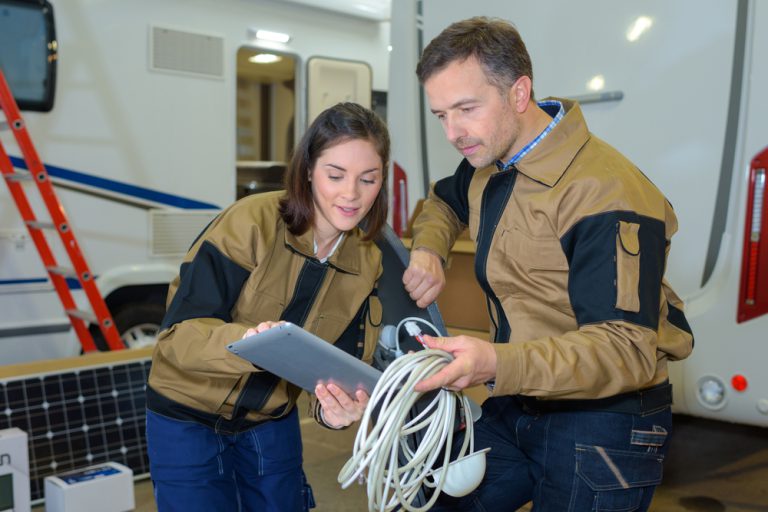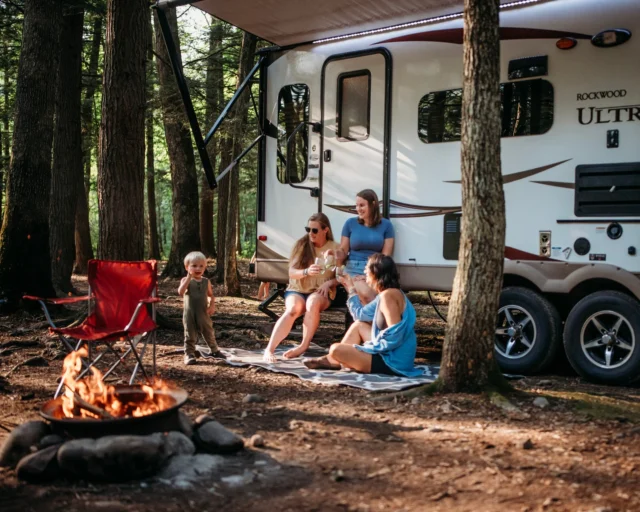
 As wonderful as RVing is, it can be costly — and we’re not just talking about the upfront costs of buying the rig. There’s also campground fees, fuel, and other vacation-related expenses to consider… not to mention every RVer’s least-favorite M word: maintenance.
As wonderful as RVing is, it can be costly — and we’re not just talking about the upfront costs of buying the rig. There’s also campground fees, fuel, and other vacation-related expenses to consider… not to mention every RVer’s least-favorite M word: maintenance.
Fortunately, there are ways around most of these high-cost realities, including paying for expensive professional RV repair work. For example, you can get half off your campground accommodation fees at almost every campground you stay at by purchasing a Passport America membership, and you can DIY a lot of basic RV maintenance which, along with a little dose of luck, can help keep your rig out of the shop.
So if you never again want to find yourself Googling the words “RV maintenance near me,” read on. Here are some tips and tricks to help you get down and dirty with taking care of your rig on your own, so you don’t have to pay some repair shop the big bucks it takes for them to do it.
Basic RV Maintenance
Here are some RV maintenance 101 items to keep you from shelling out serious cash at the RV repair center in the near future.
1. Take care of your tanks.

Having an onboard bathroom is one of the highlights of the RVing lifestyle for many travelers. Even if you’re not a germophobe, there’s something to be said for not having to rely on public restrooms.
But your RV’s plumbing system can be a sensitive thing — and after all, it does a lot of work! It reroutes and holds both black and gray water, as well as piping fresh water in through your taps, shower, and toilet.
As you can imagine, those holding tanks can get pretty… well, gross after a while. So one of the most important parts of black and gray water tank maintenance is simply to ensure you fully empty them each and every time you’re done with a trip, and take the time to fully sanitize them with a diluted bleach solution occasionally, too. We’ve written about how to scrub your RV’s tank sensors, which can accumulate dirt over time and make them less accurate. It’s always nice to know when your RV has to go!
2. Pay attention to your HVAC system.

If there’s another feature on your RV you definitely don’t want to live without (aside from the bathroom), chances are it’s your climate control. The ability to power on the AC or furnace can turn an otherwise miserable camping experience into a luxurious getaway, while the opposite also holds true. (Trust me: I’m from Florida, and have attempted to sleep in an un-airconditioned RV in August.)
That’s why keeping up with basic RV furnace and AC maintenance can go a long way toward keeping you a happy camper for the foreseeable future. It can be as simple as checking and swapping out your filters as they get dirty or as complex as discovering a broken condenser, but if you’re willing to get hands on, sometimes, you can avoid making an expensive (and time-intensive) replacement. Here’s our post on what to know about your RV’s HVAC system, including what to consider if you are in the market for a new one.
3. Basic RV Battery Maintenance

If there’s one thing that can put a damper on your camping trip quick, it’s a bum battery. But what goes into basic RV battery maintenance?
The truth is, the answer to that question depends on what kind of RV battery you have. For example, if you’re traveling in a Casita with an upgraded marine-style battery, you usually don’t have to worry about checking water levels. And if you’ve upgraded to lithium batteries, you don’t have to be as concerned about exposing the battery to colder temperatures, which could drain its life.
But when it comes to traditional RV batteries, you do need to service them on a regular basis: checking water levels, adding more water if needed, keeping them at relatively moderate temperatures, and looking for signs of sulfation.
4. RV Roof Maintenance

Simultaneously one of the most easy RV maintenance tips and one of the most overlooked is to keep an eye on your roof — not literally, of course, but making sure to give it a once-over every so often. We recommend climbing the ladder to take a look at your RV’s roof before and after every camping trip, and making a point of clearing your roof of dirt, debris, and sticky sap that may have fallen off of overhanging tree branches.
These seemingly-cosmetic issues can actually have a major effect on the longevity of your roof; by destroying the finish, they can lead to water damage, which is one of the most common causes of RVs going kaput. While you’re up there to do the cleaning job, you can also take a look at the seals along your RV AC system and other openings in the roof, such as your vent fans, and go over them with some RV sealant if necessary.
A good way to get ahead of RV roof maintenance issues while your rig is in storage is to simply ensure that you’re storing it indoors if at all possible — though we know it can be difficult to find an affordable way to do so. That’s why it’s also a great idea to invest in a high-quality RV cover, which can protect your paint job from harmful UV rays as well as keeping dirt, dust, and water out of your RV for the entirety of the time it’s in storage.
5. RV Slide Out Maintenance

RV slide outs are such a love-hate thing. We love them, because they can turn even the most modestly-sized RV into a palatial bungalow on wheels… but we also have to admit that they’re basically one giant maintenance issue waiting to happen. The physics of it speaks volumes: moving all that weight along a narrow metal strut and trying to ensure the seals stay watertight is a feat of engineering, and it often breaks down after multiple usages.
We can tell you from experience that having to figure out an RV slide out repair issue can be… well, less than fun, especially if your slide-out holds uber-heavy and expensive furnishings like a fold-out sofa. Having to wait around for the local RV maintenance and repair place to get your slide-out back in working order can cause major delays to your trip and keep you grounded, because even if you don’t want to use the slide-out, you usually have to have it in good working order to move the rig.
While there’s not a whole lot you can do to guarantee you’ll never run into issues with your slide-out, you can go out of your way to ensure it stays well-lubricated, which can be one of the biggest problem-causing agents when it comes to slide-outs. Ensure the lubricant you choose is safe for all the nearby materials, and use it to bring moisture to all the moving parts supporting your slide-out.
You’ll also want to double-check the slide-out awnings before you roll them back in at your campsite. Dirt, debris, and tree detritus can get in there and cause your slide-out to stick or make it impossible to bring in, jamming up the machinery and causing longer-term problems.
More RV Maintenance and Repair Tips
While we’ve tackled some of the most easily-overlooked RV maintenance issues here — and ones that are apt to keep you from facing a major bill at the repair shop — the truth is, every RV has its own specific maintenance needs, and they include both interior, household stuff as well as regular motor maintenance steps like the ones you perform on your car. Tire rotations and oil changes are all operations that you may or may not feel comfortable performing on your own. But even if you have to hire them out to a professional, you definitely want to keep up with them — because the repairs you’ll face by letting them lapse are much costlier than the cost of simple upkeep.
Looking for more tips on DIY RV maintenance… or how to find a trustworthy repair person if you do need professional aid? Here are some RVshare blog posts that might help you.
- How to Perform Routine Maintenance on Your RV
- Creating a Preventative RV Maintenance Schedule
- RV Cleaning, Storage and Maintenance: Must-Have Products
- Spring Maintenance for your RV
- RV Repair Near Me: Tips for Finding a Trustworthy RV Repair Service
This post may contain affiliate links.






